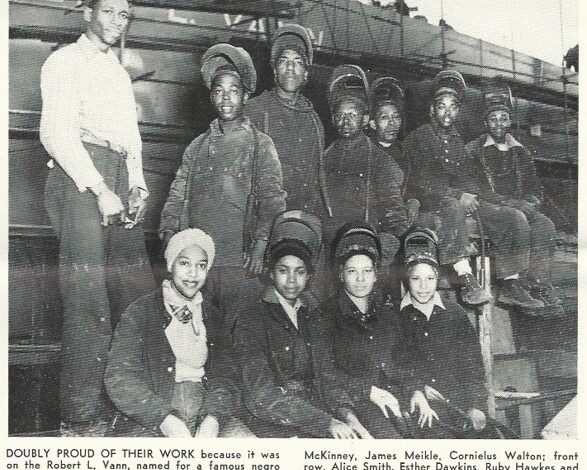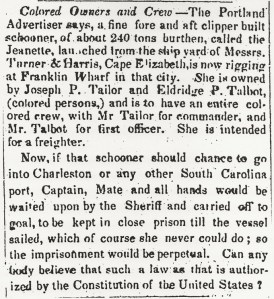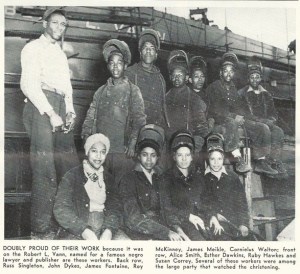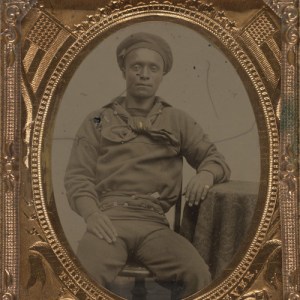Black sailors in Maine and New England

Second in a series.


An article about the clipper-schooner Jeanette from the New London (Connecticut) Daily Chronicle, April 25, 1853. South Portland Historical Society image
We continue from last week with our look at Black sailors in Maine and New England. In the first half of the 19th century, the docks of Portland were worked by Black longshoremen. Many of these individuals arrived in Portland through trade with the West Indies alongside cargoes of molasses and rum.
William Gould, writing in the Portland Press on April 13, 1872, noted that the Black longshoremen were known for their singing which was employed to keep time as they labored to unload cargoes of molasses by hand. According to Gould, “They were sure to have a large audience to hear their singing. Many church-going people on coming out of meeting…then took Fore street on their way home, no matter where they lived.”
Black laborers on the Portland waterfront were pushed out of the occupation by Irish immigrants fleeing famine in the 1840s and 1850s. One method of exclusion was the formation of unions that didn’t allow Black people to join.
The money generated by Black sailors, and people who worked in related jobs, helped to fund community institutions such as sailors’ benevolent societies, organizations that cared for elderly and injured sailors. It also funded houses of worship like Portland’s first Black church and community center, the Abyssinian Meeting House.
Cosmopolitan Black sailors were instrumental in the formation of a collective African identity in the Atlantic world (Europe, Africa and the Americas) and were critical to sharing information within this community.
The barber shop of Jacob C. Dickson, once located at 243 Fore St., is one of the 16 sites that make up the Portland Freedom Trail. The Black-owned barbershop sat right on the Portland waterfront before Commercial Street was built in the 1850s. The barbershop was an important crossroads of information where Black sailors, coming directly off recently-arrived sailing vessels, could go and share information about the Atlantic World African community. Information about slave revolts, abolition and the Underground Railroad would have been shared there. The barbershop also kept a stock of wigs and fake beards on hand for self-emancipating enslaved Africans, who had stowed away in southern U.S., to disguise themselves.


From the New England Keel, Oct. 15, 1943. South Portland Historical Society image
Black sailors and Black people engaged in related maritime industries were crucial to the activities of the Underground Railroad.
In “Sailing to Freedom: Maritime Dimensions of the Underground Railroad,” author Timothy D. Walker maintains that self-emancipation from the deep South would be extremely difficult over land. Instead, enslaved Africans were more likely to stowaway on a north-bound ship. This was sometimes done with the aid of free Black sailors from the North. Once these self-emancipating individuals reached a northern port like Portland, free Blacks working in maritime industries would assist them.
This was not without risk for free Black sailors.
Southern white enslavers promoted laws like South Carolina’s 1822 Negro Seamen Acts which stipulated that free Black sailors were to be jailed for the duration of their port visit in an effort to keep them from interacting with the enslaved. There was also the ever-present risk that a Black sailor could be claimed as a White person’s property.
South Portland has an interesting connection to the history of Black mariners. In 1853, a 240-ton “schooner clipper” was built by Eben Turner and business partner Steven Harris at the Turner Shipyard along the South Portland waterfront. The ship was built for two Black mariners, Joseph Taylor and Eldridge Talbot. The vessel was named the Jeanette after Taylor’s wife. With Taylor as captain and Talbot as first officer, the Jeanette sailed with an all-Black crew. They made a series of voyages to the West Indies, including at least one voyage to obtain guano (bird and bat droppings used in fertilizer and gunpowder production).
According to various obituaries published at the time of Taylor’s death, Taylor was the first Black American to have a ship built for him and to captain his own ship.


An unidentified African American sailor in a Union uniform. Courtesy photo/Library of Congress
As steamships became more popular than sailing vessels in the second half of the 19th century, Black Mainers continued to work in maritime trades. People of African heritage worked as firemen (also known as “stokers,” these workers shoveled coal into shipboard boilers), stewards, stewardesses, porters, and cooks.
According to “Maine’s Visible Black History: The First Chronicle of Its People:” “Black stewards abounded on schooners and steamers. Their work included scrubbing the decks, keeping the oil lamps filled and cleaned, and polishing brass. James E. Atus, who grew up in Machias, reported that his father-in-law, James Weedman of Portland, was a steward for steamers between Boston and Portland for forty years during the latter part of the nineteenth century. In Portland, blacks sometimes left the crew of long-distance steamers and signed on with the Casco Bay Lines, to be closer to their families.”
The SS Portland was a side-wheel steamship plying the route between Portland and Boston. She sank on Nov. 27, 1898, in one of the worst storms in New England history. All of her estimated 192 crew and passengers perished in the waters off of Massachusetts. Portland’s Munjoy Hill Black community was particularly devastated. Lost were 19 members of the community who were working onboard the vessel, including first steward Francis Eben Heuston and fireman Harry Rollinson. The Black community of Portland at that time included only about 400 individuals. These deaths constituted a loss of 5% of the community and many families on Munjoy Hill lost a loved one and a breadwinner.
Maritime-related jobs were still important to Maine’s Black community in the 20th century. South Portland’s World War II-era shipyards, where Liberty ships were built, employed people from around the region. Some of these men and women were of African heritage. A photograph published in the New England Keel on Oct. 15, 1943, shows some of these workers. Pictured are Black men and women, most wearing welding gear, in front of the hull of the SS Robert L. Vann. The vessel was named after Black American Robert L. Vann, who published one of the nation’s leading Black newspapers at the time, the Pittsburgh Courier.
The society is always enthused to learn more about local history. If you have information related to this topic, please contact South Portland Historical Society at 55 Bug Light Park, South Portland, ME 04106, by phone at 207-767-7299, or by email at sphistory04106@gmail.com. Thank you.
Seth Goldstein is the development director of the South Portland Historical Society and also serves as the director of the society’s Cushing’s Point Museum. He can be reached at sphistory04106@gmail.com.
Related Stories

























































